The first School Gaudies commenced as soon as the move to Summertown was made in 1872-3 and at first were held in spring, summer and winter. Each was an opportunity for prize giving of different kinds, but the summer event was the main occasion when parents, friends and, later, OSE would attend in ever greater numbers.
To add some confusion, the early Gaudies were called by different names including ‘St. Edward’s Day’ and ‘Commemoration’ or ‘Commem’. It wasn’t until the 1930s that Warden Henry Kendall finally decided that there would be two specific events in the School calendar, the Summer Gaudy, usually held in either June or July, aimed at parents and families at the end of the School year – and the Winter Commemoration (‘Commem’) in November to remember the fallen and to welcome back OSE. Two separate occasions for two key audiences.
Below: Gaudy 1899, the earliest known picture

Another early Gaudy scene, 1904:
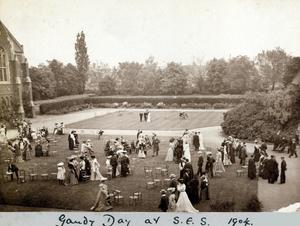
In the years up to the Great War, during which the School was continually building, leasing then buying land and slowly growing pupil numbers, the Gaudies in the Summer Terms were events not to be missed. The School was out to impress not only parents and prospective parents, but also the dignitaries of Oxford and the local citizenry of Summertown and surrounding area.
There was a regular format for the annual Gaudy which included the traditional prize-giving speeches from the Warden and those in high office at the School, cricket matches, rowing races and the tea party in the Quad (weather permitting) were key attractions. After 1910 the Corps would parade at various times as well. Chapel services would be central to everything, with three services offered and usually very well attended and compulsory for the pupils.
In certain years there were good reasons for Gaudies to be much larger events than normal, such as the opening of the Chapel in 1877 when the Bishop of Oxford was present and 400 guests attended.
The early prizes were heavily weighted towards the Classics, Divinity and ‘Good Conduct’. Mathematics and History were added in 1875, English prizes in 1877, German and French a year later. The Sciences, Geography and other languages followed in 1893.
The choice of guest speaker and prize presenter through the years makes for interesting research, as from the Kendall era onwards these dignitaries were clearly selected for very specific reasons and sometimes with an ulterior motive! This was not the case early on, as while for the first few years outside guests undertook the task, including the Founder, from 1880-1928 the Wardens always took this role. No explanation is readily available for this policy and it may have been just one of expediency, as this was the one occasion during the year that the Warden could speak directly, in person, to the parents and outside world in a time before mass media. They wouldn’t have wanted to miss the opportunity to get across their particular message. This would all change in the twenties with the arrival of Henry Kendall.
In the early 1900s the now-growing number of OSE started to play sports and also dine together, sometimes during Gaudy, but more often at the time of Commem in Oxford and London. These black-tie events would continue for many years.
1913 was the School’s fiftieth anniversary and, quite naturally, the Gaudy that year was a sumptuous affair. Over 500 guests came to Oxford and the School was ‘filled to utmost capacity’.
The Bishop of London was the Guest of Honour and officiated at the morning service when even ‘the side chapel and organ loft were full’. The demand for attendance was such that only OSE who were bona fide members of the Society received an invitation. In the afternoon a very strong OSE Cricket XI (with six former captains included) soundly thrashed the School XI. During the Great War there were no Gaudies, as Warden Ferguson felt such ‘celebrations’ were not in keeping with the great sacrifices being made by OSE and staff at the war fronts. In fact, there was to be no return to the traditional Gaudy or Commem in Ferguson’s final years up to 1925. What was, however, introduced in the Ferguson era was the importance of School music and the Warden, together with his brilliant Music Master. Dr Walter Stanton, built up the standards of the School Choirs and musical talents were displayed as often as possible when parents came to the School. Music later became part of the Gaudy tradition.
The Gaudies after the arrival of the sixth Warden, Henry Kendall, in 1925 would be very different, like many other things at St Edward’s. He bided his time, then in 1928 brought back Gaudy in the Summer Term, on this occasion allowing himself the stage as the main speaker and prize giver. The whole event was updated and in the years that followed would provide some of the most memorable summer festivals that OSE can recall. One day stretched into three and the events were, compared with what had gone before, lavish, extensive and impressive. Chapel services still formed a solid basis, the prize-giving was held in either the Dining Hall but more usually in Big School then festivities transferred into large marquees on Upper One but more often in the Quad. Every boy was involved in one way or another, there were displays of all kinds, mass PT on Upper One, swimming/diving in the outside pool, OTC (later CCF) parades, and always cricket matches and rowing races against the OSE. In the evenings there were theatricals, concerts with choirs as large as one hundred singers, with Staff and OSE providing the bass voice balance. Weather always seemed to be right – but on the few occasions it wasn’t, the show went on regardless. Attendances were always in the hundreds and some visitors came from long distances to attend. Whenever possible, outside military/ police bands were invited to play and the local press and Summertown residents were usually present.
From 1929 until his final Gaudy in 1954, Kendall always ensured his guest speaker and presenter was judiciously chosen, including other Headmasters, leading Oxbridge figures, Bishops, very high-ranking servicemen, politicians and perhaps most important three Chairmen of Barclay’s Bank (the School’s bankers!). His real coup was in 1939 when HRH the Princess Royal agreed to open the Memorial Cowell Gates onto the Woodstock Road. She would be the first member of the royal family to ever visit the School and also the first woman to ever perform the task of presenting the prizes.
Below: HRH the Princess Royal opens the Cowell Memorial Gates.
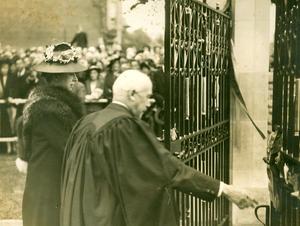
Everything changed with WW2, although Kendall tried to keep the tradition going, while fully realising that the OSE and many parents were otherwise engaged. He called them ‘Pocket-Gaudies’ or ‘Ersatz-Commems’ as so few turned up: petrol was scarce, and curfew made long distance travel impossible. But there was still cricket and rowing on view, ‘war-time teas’ and a warm welcome for all who made the effort to come. Kendall’s last Gaudy in 1954 was an emotional one and he again presented the prizes (he had booked the Archbishop of Canterbury two years before, who sadly was ill on the day!) as well as opening the new Memorial Library. There was a turnout of well over 600, with many OSE included.
The Gaudies of the fifties and sixties gradually built up to pre-war levels as rationing eased and strawberries and cream returned. The mass displays gave way to more specific exhibitions concentrating on the diverse interests within the School, the three-day format was shortened and attendance by the pupils to the Gaudy Chapel services was no longer compulsory. Music played an ever bigger part, including performances from the various School orchestras and bands quite apart from the choirs and choral singers often provided the rousing finale.
Below: Gaudy, circa 1950
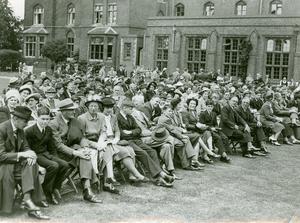
Below: Gaudy, 1954
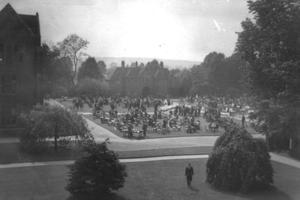
Warden Fisher, like his predecessor, used his contacts to coax such celebrities as Field Marshal Montgomery, Sir George Mallaby and Sir John Betjeman to be guests of honour. In 1963, the School’s centenary, there was another huge celebration taking place over four days. It was a real ‘Red Carpet’ affair with several dinners, firework displays, ‘Son et Lumière’ in the floodlit Quad, the band of the Royal Marines, Centenary Concert, Chapel Services, marching displays, gymnastic and swimming galas and a flypast by members of the Air Section of the CCF. There was the presence of the ex Archbishop of Canterbury and no less than three other OSE Bishops! Between 1500 and 2000 guests took part.
In 1968 John Harding-Davies (OSE), who went on to be a cabinet minister in a Thatcher Government, became the first alumnus to present the prizes.
Below: Gaudy, 1981
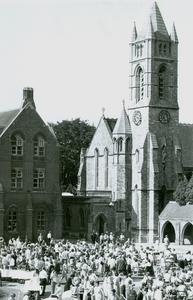
Below: Gaudy, 1985

Below: Gaudy 1992

Through to the present day the Gaudies have remained the main date in the School calendar and as the School has grown and moved into a co- educational establishment, changes have been made to allow for the number of extra guests and changing trends. Large numbers of guests now have to be accommodated and the number of attractions include the Arts in many forms including theatre and dance as well as music but with the traditional events remaining.
In 2013 the 150th anniversary was celebrated in very grand style with 3000 visitors from all over the world descending on Oxford for the three packed days. It was a massive event which took 18 months to organise and was a great success. The weather co-operated fully – concerts were held on a specially constructed stage in the Quad with smaller stages elsewhere, cricket was played, ears were pricked as to what the VIII were doing at Henley, the band of the RAF played, there was a flypast, the Science building was officially named as was the latest girls’ boarding House and of course there was a bouncy castle.
2020 was a unique Gaudy as it never happened in reality, but virtually, a combination of creative minds at the School using the latest technology to ensure the Coronavirus didn’t disrupt the annual festivities any more than it needed to. One imagines Simeon would have been both dazzled and delighted by the outcome.



Fascinating!